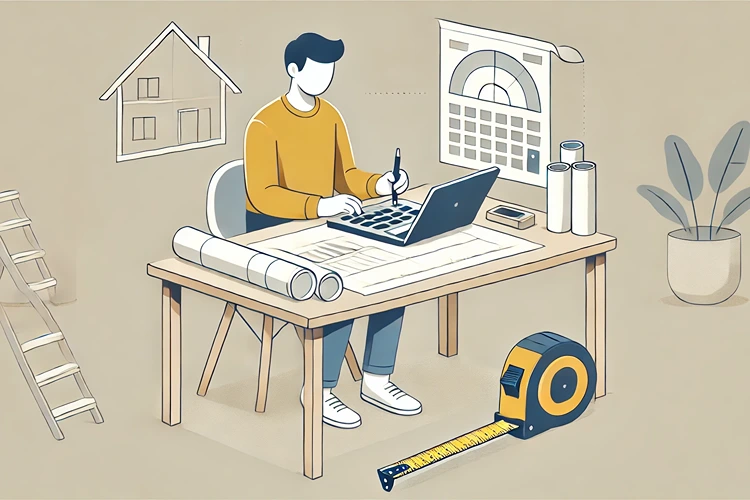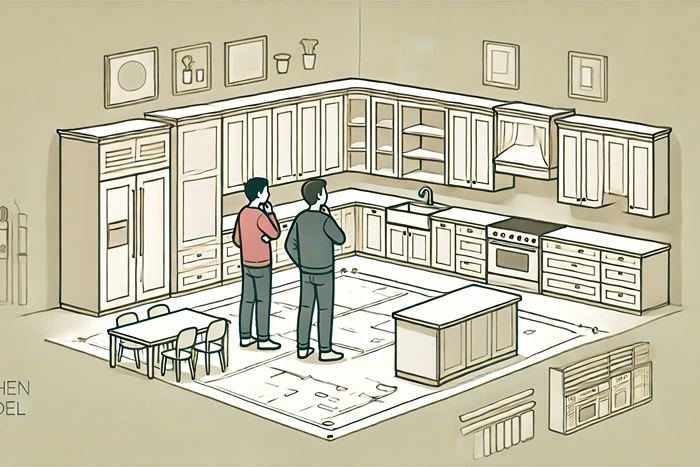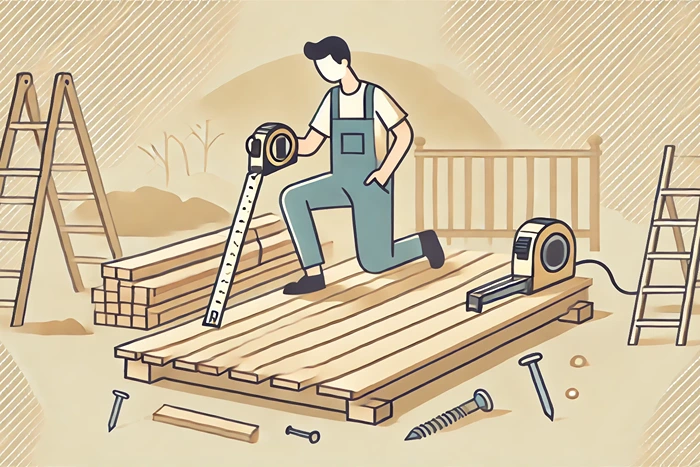Calculating Home Improvement Costs with a Project Calculator

Home improvement projects can be both exciting and overwhelming. From upgrading your kitchen to building a deck, there’s always a sense of accomplishment when the work is done. But before you get there, one crucial aspect needs careful planning—costs. Many homeowners underestimate how much their home improvement projects will actually cost, leading to delays or compromises in quality. That’s where a project calculator comes in handy. With the right tools, you can better estimate the cost of your project, making budgeting and decision-making much easier.
What Is a Project Calculator?
A project calculator is a digital tool that helps homeowners estimate the cost of home improvement projects. It takes into account various factors, such as materials, labor, and additional expenses like permits or unexpected repairs. This allows you to have a realistic idea of how much your project will cost before you even start.
Most project calculators allow you to input specific details of your renovation or build, such as the size of the space, the type of materials you’ll be using, and even local labor rates. Based on this information, the calculator provides an estimated total cost, helping you avoid surprises.
Helpful Hint:
Before you start your project, gather a detailed list of materials and tasks to input into your project calculator. This will give you a more accurate estimate and help prevent unexpected costs.
Why Use a Project Calculator?
Using a project calculator is essential for anyone looking to make home improvements without breaking the bank. Here are a few reasons why it’s beneficial:
- Accurate Budgeting: By using a project calculator, you can allocate your finances effectively and avoid costly surprises along the way.
- Save Time: Instead of manually calculating costs, a project calculator does the heavy lifting, providing quick and accurate estimates.
- Decision-Making: Knowing your estimated costs upfront helps you make informed decisions, such as whether to upgrade materials or hire professionals.
- Comparison Shopping: You can compare different project calculators or material costs to ensure you’re getting the best deal.
How to Calculate Costs for a Kitchen Remodel

The kitchen is one of the most popular areas for home improvement projects, but it can also be one of the most expensive. A project calculator can help break down the costs of a kitchen remodel by factoring in specific elements like cabinetry, countertops, flooring, and appliances. Here’s a rough breakdown:
- Cabinetry: This often takes up a large chunk of the budget, especially if you opt for custom cabinets.
- Countertops: Materials like granite or quartz are more expensive but offer durability and aesthetic appeal.
- Appliances: High-end appliances can quickly add thousands to your total, so be sure to factor them in.
- Labor: Don’t forget to include labor costs, which can vary depending on your location and the complexity of the project.
By entering these details into a project calculator, you’ll get a better sense of what you’ll need to spend, helping you budget for the remodel without overspending.
How Much Will a Deck Cost?

Building a deck can add value to your home and provide a great outdoor space for entertaining, but it’s important to calculate costs before jumping into construction. Deck prices vary based on factors like size, materials, and labor. Here’s how you can use a project calculator to estimate the cost of a deck:
- Deck Size: The larger the deck, the higher the cost. Project calculators typically ask for dimensions, so be sure to measure your space accurately.
- Materials: Pressure-treated wood, composite decking, or exotic hardwoods can greatly impact your overall costs. Composite materials tend to be more expensive but require less maintenance over time.
- Labor: If you’re not building the deck yourself, don’t forget to include the cost of hiring a contractor.
- Permits: In some areas, you may need a permit to build a deck, which can add to the total cost.
Helpful Hint:
When building a deck, always leave a buffer in your budget for unexpected expenses, such as soil issues or higher material costs. A project calculator can help account for these potential surprises.
What Factors Influence Home Improvement Costs?
Several factors can influence the overall cost of a home improvement project. While a project calculator will help estimate costs, understanding the key variables can help you plan more effectively:
Materials
The type of materials you choose will have a significant impact on the cost of your project. High-end materials like natural stone or hardwood can increase the price considerably, whereas more budget-friendly options like laminate or vinyl can help you save money. When using a project calculator, be sure to input the correct material type to get the most accurate estimate.
Labor
Labor costs can vary depending on your location and the complexity of the project. For example, specialized labor like electricians or plumbers will generally cost more than a general contractor. A project calculator will often ask for your location to give a more accurate labor cost estimate.
Permits and Regulations
Some home improvement projects, especially those involving structural changes or additions, require permits. These permits can add to your overall costs and vary by location. Be sure to factor them into your project calculator to avoid surprises later on.
Stats:
According to the National Association of Home Builders, permits can add anywhere from $500 to $2,000 to the cost of a major home improvement project, depending on your location.
In the next part, we’ll dive deeper into how to use a project calculator effectively and explore additional tips to help you manage your home improvement budget wisely.
How to Use a Project Calculator Effectively
Now that you understand the basics of a project calculator, let’s go over how to use one effectively. A project calculator is only as accurate as the information you provide, so it’s essential to input the correct details for each aspect of your home improvement project. Here’s a step-by-step guide to ensure you get the best results:
Step 1: Gather Your Project Details
Before using a project calculator, take the time to gather all the relevant information about your home improvement project. This includes measurements, material choices, and any additional features you plan to include. The more detailed your inputs, the more accurate your estimate will be.
- Measurements: Whether you’re remodeling a room or building a deck, accurate measurements are crucial for cost estimation. Measure the space precisely and note down the dimensions.
- Material Selection: Decide on the materials you’ll be using, whether it’s flooring, paint, or decking. Different materials come with different costs, so be specific when entering this information into the calculator.
- Labor Costs: If you’re hiring professionals, make sure to include labor costs in your estimate. These costs can vary widely, so check local rates before entering them into the calculator.
Step 2: Input Data Into the Calculator
Once you’ve gathered your information, start entering it into the project calculator. Most calculators will guide you through the process by asking specific questions related to your project. Here’s what you can expect:
- Dimensions: Enter the measurements of the area you’re working on.
- Material Choices: Input your chosen materials, like hardwood flooring, ceramic tiles, or composite decking.
- Labor: Add the estimated labor costs, based on the complexity of the work and the rates in your area.
- Miscellaneous Costs: Don’t forget to include additional expenses like permits, delivery fees, or unforeseen repairs.
Step 3: Review the Estimate
After inputting all your details, the calculator will provide an estimate. Review the breakdown carefully, paying close attention to individual costs like materials, labor, and any extras. This will help you identify areas where you may want to adjust your plans to stay within budget.
Managing Costs for Smart Home Technologies
With the rise of smart home technologies, many homeowners are looking to integrate these features during renovations or home improvement projects. While smart home devices can increase your home’s value and convenience, they also add to the overall cost of a project. Here’s how a project calculator can help you estimate the costs for smart home integration:
- Smart Lighting: Installing smart lighting systems can range from $100 to $500 depending on the brand and complexity of the installation.
- Security Systems: Smart security systems with cameras, motion sensors, and alarms can cost anywhere from $500 to $2,000.
- Smart Thermostats: A smart thermostat might cost between $200 and $500, with potential savings on energy bills down the line.
These costs can be easily input into a project calculator to give you a realistic idea of what to expect when integrating smart technology into your home improvement project.
Helpful Hint:
When planning to install smart home technology, check if your existing electrical system can support the new devices. You may need to upgrade your wiring, which can add to your overall costs.
Cost Comparisons: DIY vs. Hiring a Professional
One of the key decisions in any home improvement project is whether to tackle it yourself or hire a professional. Both options have their pros and cons, and a project calculator can help you decide by estimating the cost differences. Here’s a breakdown of how DIY and professional costs can compare:
DIY Projects
If you’re handy and have experience with home improvement, doing it yourself can save a lot of money. With a DIY approach, you only need to account for the cost of materials and any tools you might need to purchase. However, there are some considerations to keep in mind:
- Time: DIY projects can take longer, especially if you’re learning as you go.
- Skill Level: If you’re not experienced, you might need to invest time in learning or risk making mistakes that could increase costs in the long run.
- Permits and Codes: Some projects require permits or adherence to building codes. Make sure you’re aware of these regulations to avoid fines.
Hiring a Professional
Hiring a professional ensures that the job gets done correctly and often more quickly. While this comes with added labor costs, it can save you from potential headaches and costly mistakes. Here’s what you should consider when budgeting for professional help:
- Labor Costs: Contractors usually charge based on the complexity of the project and their expertise. Labor costs can range from $50 to $150 per hour depending on the task.
- Guarantee: Many professionals offer warranties on their work, which can provide peace of mind and add value.
- Permits and Inspections: Professionals will often handle permits and inspections, ensuring that your project meets local regulations.
Stats:
According to HomeAdvisor, the average cost of hiring a general contractor for a home improvement project is about $4,000 to $12,000, depending on the scope of the work.
Using a project calculator can help you compare the potential costs of a DIY project versus hiring a professional, allowing you to make an informed decision.
Common Mistakes to Avoid When Calculating Home Improvement Costs
Even with the help of a project calculator, there are some common mistakes homeowners make when budgeting for home improvement projects. Avoid these pitfalls to ensure your project stays on track:
Underestimating Material Costs
One of the most frequent mistakes is underestimating the cost of materials. Prices can fluctuate, especially for items like lumber or paint. Always leave room in your budget for price increases or higher-than-expected material needs.
Ignoring Hidden Costs
There are often hidden costs in home improvement projects, such as delivery fees, permit costs, or unexpected repairs. A project calculator helps, but make sure to include a contingency fund to cover these surprise expenses.
Not Factoring in Time
Time is money, especially if you’re hiring professionals. Delays can lead to increased labor costs, so plan your project timeline carefully to avoid extra expenses.
In the final part, we’ll explore tips for staying on budget and using project calculators for long-term planning.
Tips for Staying on Budget During Home Improvement Projects
Once you’ve calculated your home improvement costs using a project calculator, it’s essential to stay on budget to avoid financial stress. Sticking to a budget can be challenging, but with the right strategies in place, you can complete your project without overspending. Here are some tips to help you stay on track:
Set a Realistic Budget
Before you even start your project, set a realistic budget that includes all aspects of the renovation, from materials to labor and permits. Be honest with yourself about what you can afford and don’t stretch beyond that limit. A project calculator is a great tool to help you build an accurate budget by providing an estimate based on the specifics of your project.
Track Your Spending
One of the most effective ways to stay on budget is to keep track of your spending throughout the project. Use a spreadsheet or budgeting app to monitor how much you’ve spent compared to your original estimate. This will help you identify any areas where you may be overspending, allowing you to adjust before things get out of hand.
Prioritize Your Needs vs. Wants
It’s easy to get carried away with upgrades and luxury items, but these extras can quickly blow your budget. Focus on the essential aspects of your project first, such as structural repairs or necessary updates, before splurging on high-end finishes. If you find yourself going over budget, consider scaling back on non-essential items.
Helpful Hint:
When choosing materials, look for cost-effective alternatives that still provide quality and durability. For example, engineered wood can mimic the look of hardwood floors at a fraction of the cost, allowing you to achieve the desired aesthetic without breaking the bank.
Leave Room for Unexpected Costs
Home improvement projects often come with unexpected costs, whether it’s finding mold behind drywall or needing additional materials. A good rule of thumb is to add at least 10% to your overall budget to account for unforeseen expenses. This cushion will prevent you from scrambling for extra funds if something goes wrong.
Using a Project Calculator for Long-Term Planning
One of the advantages of using a project calculator is its ability to help you plan for future home improvements. If you’re considering multiple projects over time, a calculator can help you prioritize which ones to tackle first based on your budget and goals. Here’s how to use a project calculator for long-term planning:
Plan for Multiple Projects
Instead of focusing on just one home improvement project, think about the bigger picture. Do you want to remodel the kitchen this year and add a deck next year? A project calculator can help you estimate the total cost of all your planned renovations, allowing you to prioritize based on your available budget and time.
Track Cost Trends
As material prices and labor costs fluctuate, a project calculator can help you track these trends over time. This allows you to plan your projects when prices are lower, potentially saving you thousands of dollars. By comparing costs over time, you can also adjust your plans to ensure they fit within your long-term financial goals.
Invest in High-Value Improvements
Some home improvement projects offer better returns on investment than others. For example, kitchen remodels and bathroom upgrades tend to provide a higher resale value, making them worth the investment. A project calculator can help you compare the costs of various projects and determine which ones will add the most value to your home in the long run.
Stats:
According to Remodeling Magazine, homeowners can expect to recoup around 70-80% of the cost of a kitchen remodel when selling their home. This makes it one of the top home improvement projects in terms of return on investment.


